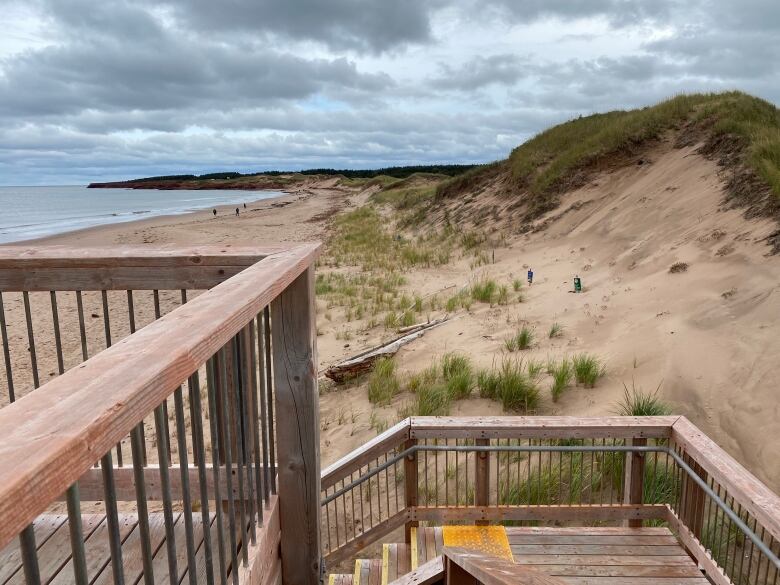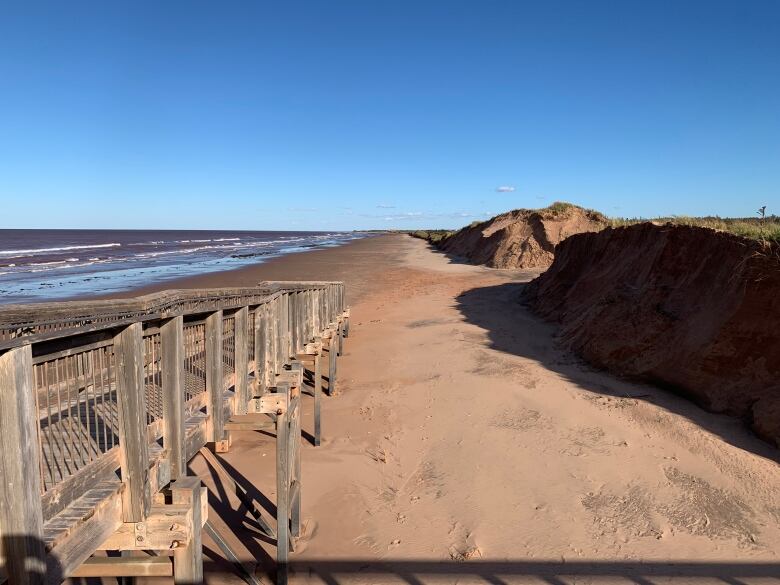P.E.I. National Park dunes suffer 'extremely dramatic' erosion from Fiona
Visitors being asked to stay away from P.E.I. National Park; some roads closed
The dunes in the Brackley Beach and Cavendish areas of P.E.I. National Park saw their worst damage in close to a century when Fiona hit Prince Edward Island on Saturday.


Scientists were able to get information quickly on the extent of the duneerosionthanks to the Coastie program, which allows visitors to the park to take photographs from a fixed location, giving accurate depictions of the erosion over time.
"What we're seeing is almost 10 metres, in some spots, of the dune having been eroded," said Chris Houser, a professor in the School of the Environment at the University of Windsor in Ontario.
"This is an extremely dramatic event. The amount of erosion, from my understanding, is reminiscent of a hurricane that passed through back in the 1930s."


Some of the sand was blown to the back of the dunes, said Houser, but much of it was clawed offshore as storm surge waves receded.
The storm's damage isn't over yet, he added. With no vegetation holding up the front part of the dune, in the near term more sand will collapse onto the beach and potentially be washed away.
Vulnerable from previous storms
Fiona brought a combination of strong winds, a storm surge that took the sea right to the foot of the dunes, and waves that were several metres high. The relatively long duration of the storm was also a factor.
Given the opportunity, said Houser, the dunes will recover.
"It's going to take a couple of years, and potentially up to a decade, for all that sediment that was lost into the near shore to make its way back to the beach and ultimately make its way back to the dune," he said.
"We've got a long recovery process ahead of us."
The dunes were more fragile than usual when Fiona hit,having not recovered from Dorian in 2019. There has also been less sea ice in recent years, which left the dunes more vulnerable to winter storms. When the ice is jammed up againthe shore, the dunes are mostly protected from the erosive action of winter storm waves.
What people can do
It remains to be seen whether substantial amounts of sand were carried far enough offshore so that it won't eventuallycome back.
As wind and waves carry somesand back, marram grass will be the first plantto move in to hold it in place, because it is spread by rhizomes. Other species, which spread by seed, will take more time. In the meantime, the dunes overall will provide a smaller habitat for the creatures that rely on it nestingbirds and small mammals.
In the meantime, it will be more important than before to stay off the dunes. Beachgoers will also have to give the dunes the room to recover, by keeping clear ofspaces where the dunes used to be.
Stay away from park for now
Meanwhile, P.E.I. National Park officials say some roadways in the park are closed and they are asking people to stay away from park sites.
The Gulfshore Parkway from Dalvay to Brackley is closed as crews assessthe damage and beginto clear debris.
"[In] P.E.I. National Park between Dalvay and Brackley, there was significant coastal erosion in this area," said Jennifer Stewart, manager of external relations with Parks Canada on P.E.I.
"It's not safe to travel on the road, so for safety reasons it is closed and we do ask that visitors please refrain from coming to any Parks Canada-administered sites at this time, as it's just unsafe."
Some park infrastructure including stairs and beach-access boardwalks was either heavily damaged or entirely washed away by the storm.
There are thousands of trees down throughout the park, blocking roadways, trails and campsites.
With files from Island Morning












_(720p).jpg)


 OFFICIAL HD MUSIC VIDEO.jpg)
.jpg)



























































































